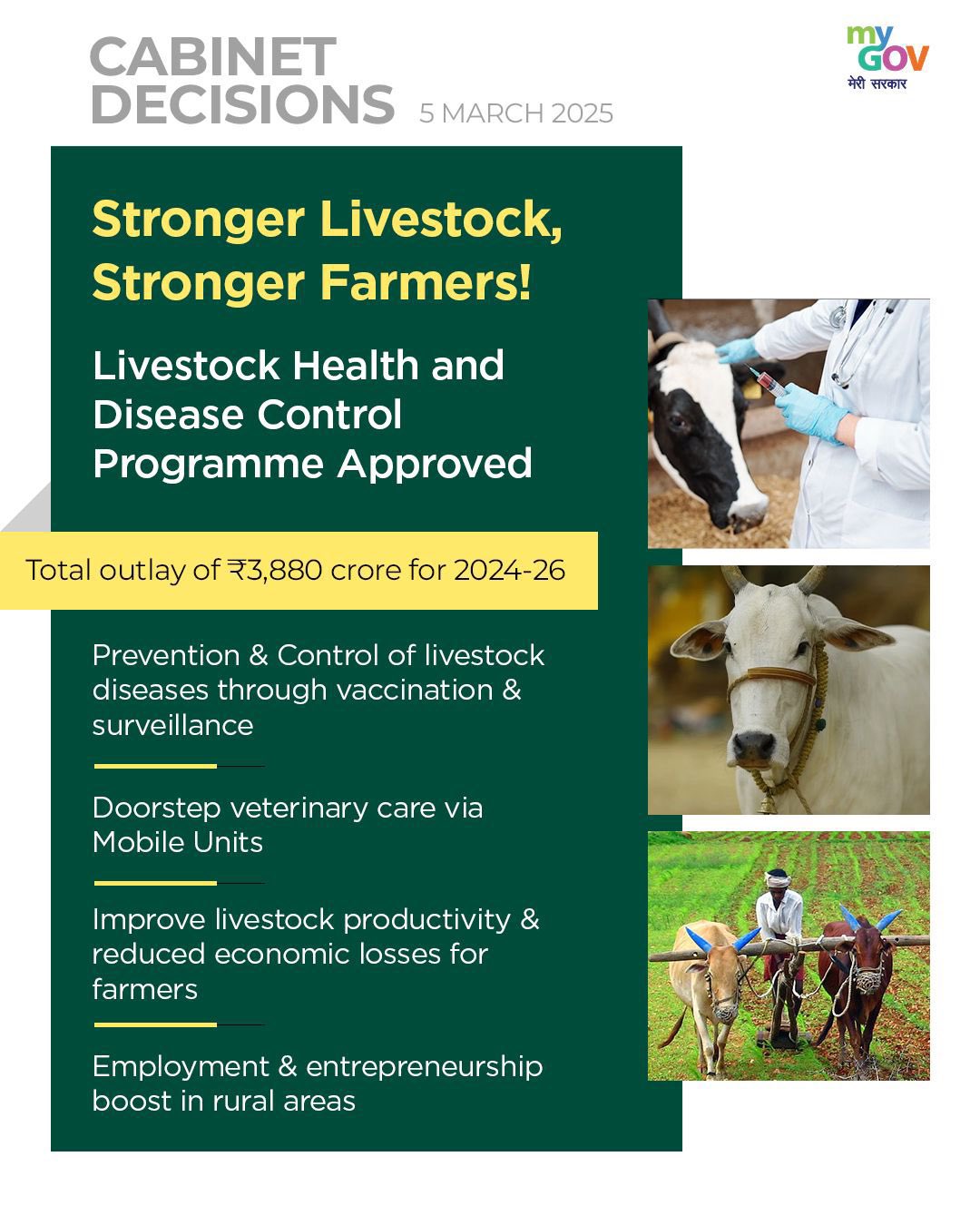Context:
The Union Cabinet has approved the revision of the Livestock Health and Disease Control Programme (LHDCP) for the period 2024-26, with an allocated outlay of ₹3,880 crore. This revision is aimed at significantly enhancing livestock disease control, thereby improving the health of animals across the country.
What is LHDCP?
The Livestock Health and Disease Control Programme (LHDCP) is a centrally sponsored scheme that focuses on improving the health of livestock in India. The programme is designed to control and prevent major animal diseases through targeted vaccinations, disease surveillance, and the enhancement of veterinary services. It also aims to support the infrastructure necessary for effective disease control, such as mobile veterinary units and improved veterinary healthcare facilities.
Key Components of LHDCP
The revised LHDCP comprises three main components, each designed to address different aspects of livestock health:
1. National Animal Disease Control Programme (NADCP): The primary focus of NADCP is to control and prevent major animal diseases, especially those that significantly impact livestock productivity. The program aims to reduce the burden of diseases like Foot and Mouth Disease (FMD) and Brucellosis.
2. Livestock Health and Disease Control (LH&DC): This component has three sub-components:
o Critical Animal Disease Control Programme (CADCP): CADCP targets critical diseases that pose significant risks to livestock health and productivity. Its aim is to control these diseases at an early stage to prevent their spread.
o Establishment and Strengthening of Veterinary Hospitals and Mobile Veterinary Units (ESVHD-MVU): This sub-component focuses on improving the infrastructure for veterinary services. It involves the establishment of new veterinary hospitals and the strengthening of existing ones. Additionally, Mobile Veterinary Units (MVUs) will be deployed to provide door-to-door veterinary services, ensuring that even remote rural areas have access to quality animal healthcare.
o Assistance to States for Control of Animal Diseases (ASCAD): This sub-component provides financial support to state governments to help them control and manage animal diseases effectively. It enhances coordination between the central and state governments for better disease control.
3. Pashu Aushadhi: A new addition to the program, Pashu Aushadhi aims to make veterinary medicines more affordable and accessible to farmers. With a budget allocation of Rs. 75 crore, this component focuses on providing high-quality, generic veterinary medicines to reduce the cost burden on livestock owners.

Benefits of LHDCP
The revised Livestock Health and Disease Control Programme (LHDCP) offer several key benefits:
- Disease Prevention and Immunization: Prevents major livestock diseases through immunization, improving animal health and productivity.
- Mobile Veterinary Services: Mobile Veterinary Units (MVUs) provide timely care, especially in remote areas.
- Affordable Veterinary Medicines: Pashu Aushadhi ensures access to quality generic medicines, reducing costs for livestock owners.
- Boosting Productivity and Employment: Enhances livestock productivity and creates employment opportunities in rural areas.
- Economic Relief for Farmers: Prevents financial losses from diseases, supporting the sustainability of livestock businesses.
Conclusion
The revised LHDCP is a comprehensive initiative that aims to revolutionize the animal health sector in India. With its focus on disease control, veterinary infrastructure, and affordable medicines, the program will significantly improve the productivity and well-being of livestock, benefiting both farmers and the rural economy.







